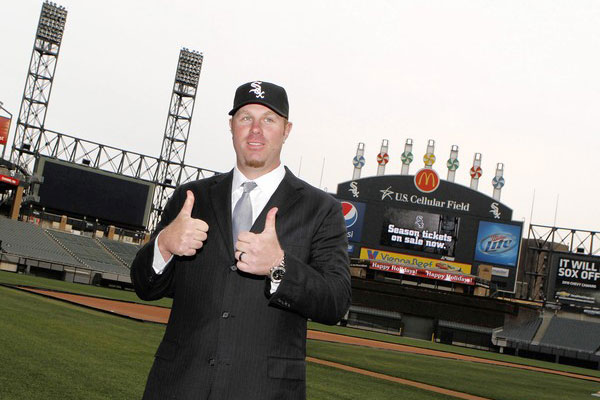
You know it’s a crappy baseball season when the big story is whether Kenny Williams would hypothetically sign Adam Dunn knowing what he knows now. He says he would, and despite the fact that Dunn is heading towards a historically bad season, I don’t think he’s just covering his butt.
Everything about it made sense: Dunn, who is a slow, terrible fielder, was born to DH; he was moving to one of the most power-hitter-friendly parks in baseball; despite his reputation for strikeouts, he’s never had an on-base percentage under .350, which is impressive; and he was coming off a couple typical seasons in the less hitter-friendly confines of DC. Dunn was pretty good in DC, after building his career in two great hitters’ parks.
Now he’s putting up a .624 OPS (on-base percentage plus slugging)—not the worst of any regular, and not even worse than (eek) teammates Juan Pierre and Alex Rios, but his worst since 2003, when it was… .819. Put it this way: the White Sox’s DH has a lower OPS than any qualified starting catcher in baseball.
Is it unprecedented? Yes and no. Dunn has never been this bad over a season. But if it makes you feel any better, he has been almost as horrible over just as long a period, in 2006. From August through October in a comparable number of at-bats (223 compared to 231), he had an .306 OBP with an .361 SLG for a .668 OPS, not that much better than he’s hitting now.
To say that Dunn is headed towards a historically bad season will get your attention; to say that he’s had the worst three months of his career since 2006 frames it differently.
Mark Gonzalez of the Trib is surprised by the number of pitches Dunn is missing, but a closer look complicates things. His percentage of swinging strikes is actually down from last year, his contact rate is up, and he’s swinging at fewer pitches outside the strike zone. They’re not great percentages by career standards—his 2010 numbers on those are career-worsts—but they’re actually better than last year, as his his walk/strikeout rate, even if he’s actually striking out more.
What is way up: his contact rate on pitches outside the strike zone, a career-high so far. What’s way down: his contact rate on pitches inside the strike zone, a career low.
So it’s actually pretty confusing.
* He’s swinging at a lot of bad pitches, more than he did in his best years.
* He’s not swinging at good pitches any more or less than usual.
* He’s not making great contact with good pitches (76 percent), but his second-worst season by that measure was 2004 (76.2 percent), his best statistical year.
* But he’s making a lot more contact with bad pitches than he ever has. By a long shot.
* And interestingly, it seems to be endemic to the White Sox. Gordon Beckham, Paul Konerko, A.J. Pierzynski, Carlos Quentin, Gordon Beckham, and Alex Rios are all at or near career highs at swinging at pitches outside the strike zone. Alexi Ramirez and Juan Pierre aren’t swinging at more pitches outside the strike zone, but they are hitting more of those pitches. It’s odd: impatience? Bad luck?
Dunn also been unbelievably horrible against lefties (1/53 for a .019 average), but a 100-point split isn’t unprecedented: he hit .199/.286 last year. So I guess .019/.219 isn’t, um, out of the question.
So what’s wrong? I’ve read everything I can think of, and everyone has a different theory: he can’t hit the fastball, he’s pressing, he’s having trouble adjusting to a new league, he’s having trouble adjusting to new pitchers, he didn’t try hard enough to adjust, he’s suffering from big slow dude syndrome, his early-season appendectomy might have affected him.
He definitely seems to be less patient than he’s been in the past, but he was less patient last year too, and that was good enough for the Sox. Here‘s a much more detailed look at how Dunn’s approach to the plate got much more aggressive with the Nationals. It’s fascinating to watch it not only grow, but to extend outside the strike zone. Now he’s on team that’s increasingly aggressive as well. Albert Lyu’s writeup is eerily prescient:
But AL Central pitchers have heard of Dunn’s power, and if they decide to pitch around him (while noting that Paul Konerko will return to the lineup in 2011), Dunn’s pitch recognition will be tested, especially if he continues to be aggressive while swinging at pitches out of the zone. Unsurprisingly, Dunn projects to hit 40 home runs again by most projection systems, but opposing pitchers will use every bit of information they can get to mitigate the damage if they realize that Dunn has indeed changed his plate approach.
Sure enough, he’s seeing fewer pitches in the strike zone than he’s ever seen in his career.
But ultimately I’m with Jesse Wolfersberger of the excellent FanGraphs blog—Dunn’s atrocious numbers, once you dig into them, seem to be as much the product of bad luck as anything else. Whatever combination of things is ailing Dunn, it doesn’t look terminal.
Photograph: Chicago Tribune


